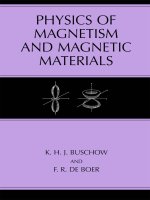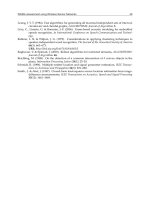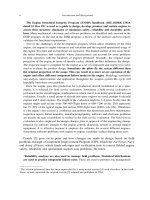Physics of Magnetism Magnetic Materials 2011 Part 3 docx
Bạn đang xem bản rút gọn của tài liệu. Xem và tải ngay bản đầy đủ của tài liệu tại đây (613.67 KB, 17 trang )
31
SECTION 4.3. ANTIFERROMAGNETISM
and hence the susceptibility by
In a polycrystalline sample, one has crystallites with all orientations relative to the field.
Since the number of orientations lying within
of the inclination is proportional to
we have for the susceptibility of a piece of polycrystalline material or for a powder sample
with
and
This leads to
The above results for the magnetic susceptibilities are generally found to be in qualitative
agreement with the properties observed for polycrystalline samples of several simple anti-
ferromagnetic compounds. A sharp maximum in the susceptibility at the Néel temperature,
or, equivalently, a sharp minimum in the reciprocal susceptibility, are generally consid-
ered as experimental evidence for the occurrence of antiferromagnetic ordering in a given
material.
Let us consider the effect of an external field H on a magnetic material for which the
magnetization is equal to zero before a magnetic field is applied. The work necessary to
generate an infinitesimal magnetization is given by
The total work required to magnetize a unit volume of the material is
For antiferromagnetic materials and comparatively low magnetic fields, we may substitute
into this equation. After carrying out the integration, one finds for the free energy
change of the system
It can be seen in Fig. 4.3.2 that below the Néel temperature This means
that the application of a magnetic field to a single crystal of an antiferromagnetic material
will always lead to a situation in which the two sublattice moments orient themselves
perpendicular to the direction of the applied field or nearly so, as shown in the right part of
Fig. 4.3.2. With increasing field strength, the bending of the two sublattice moments into
the field direction becomes stronger until both sublattice moments are aligned parallel to
the field direction and further increase of the total magnetization is no longer possible. The
32
CHAPTER 4. THE MAGNETICALLY ORDERED STATE
field dependence of the magnetization behaves as shown by curve (a) in Fig. 4.3.3. The
slope of the first part of this curve is given by and can be used to obtain
an experimental value of the intersublattice-coupling constant according to Eq. 4.3.27.
In the discussion given above, we have assumed that the mutually antiparallel sublattice
moments are free to orient themselves along any direction in the crystal. In other words,
they can align themselves perpendicular to any direction in which the field is applied.
In most cases, however, the mutually antiparallel sublattice moments adopt a specific
crystallographic direction in zero applied field. For this so-called easy direction, the mag-
netocrystalline anisotropy energy K (which will be discussed in more detail in Chapter 11)
adopts its lowest value, K = 0. The field dependence of the magnetization will then show
a behavior represented by curve (a) in Fig. 4.3.3 only if H is applied perpendicular to this
easy direction.
Quite a different behavior will be observed when H is applied along the common easy
direction of the two sublattice moments (indicated by D in Fig. 4.3.3). In this direction,
the magnetocrystalline energy has its lowest value
(K = 0), and the free energy is given
by
By contrast, if the sublattice moments would adopt a direction
perpendicular to the field direction and hence perpendicular to the easy direction (i.e., the
so-called hard direction), the free energy would be given by For
comparatively low applied fields, one has and both sublattice moments will
retain the easy moment direction. However, may become eventually the lowest energy
state because Both sublattice moments will therefore adopt a direction (almost)
parallel to the applied field. The critical field at which this happens is given by the
equation
33
SECTION 4.3. ANTIFERROMAGNETISM
which gives
This change in moment direction from the easy direction to a direction perpendicular to
it is accompanied by an abrupt increase in the total magnetization, as illustrated by curve
(b) in Fig. 4.3.3. This phenomenon is called spin flop. Of course, owing to the action of
the field applied, the sublattice-moment directions are not strictly perpendicular to the easy
direction. The sublattice moments have bent already into the field direction to some extent
and will continue to do so above
for further increasing fields.
It is interesting to note that the magnetization corresponding to curve (b) for applied
fields higher than is slightly larger than that corresponding to curve (a). The reason
for this is the following. The torque experienced by the sublattice moments due to the
applied field that forces the sublattice moments into the field direction is counteracted in
both cases by the intersublattice coupling that tries to keep the two sublattice moments
mutually antiparallel (see previous section). In the case of curve (a), the torque produced by
the applied field additionally has to overcome a restoring torque caused by the anisotropy
energy that tries to keep the sublattice moments in the easy direction. This latter restoring
torque acts in a favorable way in the case of curve (b) because the field is applied in the easy
direction now. Therefore, for a given field strength above
a larger degree of bending of
the sublattice moments into the field direction is achieved in the case of curve (b) than in
the case of curve (a).
A special situation is encountered in materials for which the magnetocrystalline
anisotropy is very large. This is illustrated by means of Fig. 4.3.4 where the field depen-
dence of the total magnetization
is plotted with the field applied in the hard direction
(curve a) and in the easy direction (curve b). In the case of curve (a), the strong anisotropy
prevents any sizable bending of the sublattice moments into the field direction. A forced
34
CHAPTER 4. THE MAGNETICALLY ORDERED STATE
parallel arrangement of the two sublattice moments, as in the high-field part of curve (a)
in Fig. 4.3.3, is not possible here. Therefore, the total magnetization remains low up to the
highest field applied. In the case of curve (b), the total magnetization remains low for low
fields. However, at a certain critical value of the applied field, the total magnetization jumps
directly to the forced parallel configuration. We will compare now the free energy of the
antiparallel sublattice-moment arrangement in the applied field with the parallel sublattice-
moment arrangement in the applied field. Using Eqs. (4.3.1) and (4.3.2) for calculating
for both situations and noting that K = 0 for all situations
on curve (b), one easily derives the critical field as
This formula expresses the fact that the sudden change from antiparallel to parallel
sublattice-moment arrangement occurs when the applied field is able to overcome the anti-
ferromagnetic coupling between the two sublattice moments. This phenomenon is called
metamagnetic transition.
4.4. FERRIMAGNETISM
In ferrimagnetic substances, in contrast with the antiferromagnets described in the
previous section, the magnetic moments of the A and B sublattices are not equal. The mag-
netic atoms (A and B) in a crystalline ferrimagnet occupy two kinds of lattice sites that have
different crystallographic environments. Each of the sublattices is occupied by one of the
magnetic species, with ferromagnetic (parallel) alignment between the moments residing on
the same sublattice. There is antiferromagnetic (antiparallel) alignment, however, between
the moments of A and B. Since the number of A and B atoms per unit cell are generally
different, and/or since the values of the A and B moments are different, there is nonzero
spontaneous magnetization below
At zero Kelvin, it reaches the value
As in Eq. (4.1.2), we can represent the exchange interaction between the various spins
and
in the lattice by means of the Hamiltonian
where is the exchange constant describing the magnetic coupling of two moments
residing on the same magnetic sublattice A (or B) or on different sublattices A and B.
Indicating the exchange constant between two nearest-neighbor spins on the same sublattice
by
(or and between two nearest-neighbor spins on different sublattices by
we can represent the three types of cooperative magnetism leading to ordered magnetic
moments as follows:
Ferromagnetism
Antiferromagnetism
and
Ferrimagnetism
and
35
SECTION 4.4. FERR1MAGNET1SM
In general, and are positive quantities but this is not strictly necessary. For instance,
there are ferrimagnetic Gd–Co compounds (see Fig. 4.4.1) in which
and
the strengths of these interactions decreasing in the sequence
It will be shown in Chapters 12 and 13 that several of the most prominent magnetic
materials are ferrimagnets. For this reason, we will discuss the magnetic coupling in these
materials in somewhat more detail. We consider a ferrimagnetic compound consisting of
two types of magnetic atoms A and B, occupying the sites of two different sublattices.
The total angular moments of these magnetic atoms will be indicated as and
The
corresponding
g
-factor are and
respectively. The magnetic moments per atom are
related to the angular momenta by (Eq. 2.2.4):
The exchange coupling between the various magnetic atoms can be described by means
of Eq. (4.4.2). If we only take into account the magnetic interaction between the spins
on nearest-neighbor atoms, the exchange interaction experienced by the spins
can be
approximated by a molecular field acting on
A similar expression can be written down for the exchange interaction experienced by
the spins The quantities and in Eq. (4.4.4) represent the exchange-
coupling constants associated with the intrasublattice interaction and the intersublattice
interaction, respectively. The number of similar neighbors and the number of dissimilar
nearest neighbors are indicated as and respectively. From Eq. (4.4.4), we
can derive an expression for the molecular field by using
or, after using Eq. (4.4.3) and
36
CHAPTER 4.
THE MAGNETICALLY ORDERED STATE
so
that
where the intrasublattice- and intersublattice-molecular-field constants and are
defined as
In the paramagnetic regime, in the presence of a magnetic field H, the two sublattice
moments are given by
where
H = 0
represents the number of A atoms per mole of atoms of the material. A similar expression
holds for A solution of Eqs. (4.4.10) and (4.4.11) with and
can be found if
The corresponding temperature, is now given by the relation
where the various types of constants
C
and
N
are given by Eqs. (4.4.8), (4.4.9), and (4.4.12).
For a given crystal structure, the number of nearest neighbors
known. In most cases, the values of
g
and
J
pertaining to the magnetic atoms are also
known. Equation (4.4.14) then gives essentially a relation between the magnetic-ordering
temperature and the magnetic-coupling constants
and
and are
In deriving expressions for the total magnetization and sublattice magnetizations in the
magnetically ordered regime, we will assume that the moments of the A and B sublattices
are aligned strictly antiparallel. This is the case if
is the only nonzero molecular-field
constant or if
is large compared to and This assumption will be more
carefully examined later. The sublattice moments are then given by
37
SECTION 4.4. FERRIMAGNETISM
where and are the Brillouin functions corresponding to the quantum
numbers and respectively, and where
It is to be noted that the two expressions for
and
in Eq. (4.4.15)
are coupled
equations since
The applied field H is assumed to be zero in Eqs. (4.4.17) and (4.4.18), since we are
interested in the spontaneous moment
The temperature dependence of can
be derived from the expression
Some illustrative examples of magnetization versus temperature curves are given in
Figs. 4.4.2 and 4.4.3, where we have assumed that
The situation shown
in Fig. 4.4.2a refers to a compound in which the A-intrasublattice interaction is antiferromag-
netic or only weakly ferromagnetic while the B-intrasublattice interaction is ferromagnetic
and much stronger. As a result, the effective molecular field experienced by the A moments
is smaller than that experienced by the B moments. This has as a consequence that
decreases more rapidly with temperature than
Figure 4.4.2b refers to a case where
38
CHAPTER 4. THE MAGNETICALLY ORDERED STATE
the effective molecular field at the A sites is stronger than at the B sites. In this case, the
spontaneous magnetization exhibits sign reversal. The temperature range in which this
occurs is indicated by the dashed line. However, since the quantity measured in practice is
the curve plotted as the full line is actually observed. The temperature
at which the resultant magnetization is zero is commonly called the compensation
point or compensation temperature.
Various other possible
curves are shown in Fig. 4.4.3. In practice, these different
types of curves are observed when the composition of the compounds investigated is varied.
For instance, there are various compounds in which rare earths (R) are combined with
3d metals
(
T
),
represented by the formula There are several possibilities for choosing
the T element (
T
= Ni, Co, Fe, Mn) and 15 possibilities for choosing the R element (see
Table 2.2.1). An example of how the compensation temperature can be shifted to lower
temperatures by reducing the R-sublattice magnetization via substitution of non-magnetic
Y is shown in Fig. 4.4.4.
It follows from the discussion given above that the temperature dependence of the
magnetization in ferrimagnetic compounds is determined by the magnitude and sign of
the intrasublattice-coupling contants
and the intersublattice-coupling constant
appearing in Eqs. (4.4.8) and (4.4.9). If the sublattice moments and are
known, these constants can be determined by fitting experimental curves of the temperature
dependence of the total magnetization M
(
T
)
. The determination of three constants by fitting
a simple M
(
T
)
curve can, however, not always be accomplished in an unambiguous way.
This is true, in particular when the M
(
T
)
curve has not much structure. This is generally the
case when it does not exhibit the singular point
at which the two sublattice
moments become equal (Fig. 4.4.2b).
A most elegant and simple method, the high-field free-powder (HFFP) method, for
determining the intersublattice-coupling constant has been provided by Verhoef et al. (1988).
In this method, the molecular-field constant
that determines the moment coupling
39
SECTION 4.4. FERRIMAGNETISM
between the rare-earth (
R
) sublattice and transition-metal
(
T
)
sublattice in ferrimagnetic
intermetallic compounds is derived from magnetic measurements made on powder particles
in high fields at low temperatures. The powder particles have to be sufficiently small in size
so that they can be regarded as an assembly of small single crystals, able to rotate freely
and orient their magnetization in the direction of the external field.
In many types of R–T compounds, the anisotropy of the R sublattice exceeds that of
the T sublattice by at least one order of magnitude at 4.2 K. By minimizing the free-energy,
it can easily be shown that under such circumstances the low-temperature magnetization
curve consists of three regions, as illustrated in Fig. 4.4.5. Below
there is a strictly
antiparallel alignment between the (heavy)-
R
moments and the T moments, so that M =
For sufficiently high values of the applied field, the R and T
moments are parallel and In the intermediate field range,
there exists a canted-moment configuration, the R- and
T
-sublattice moments
bending toward each other with increasing H. In this region, the field dependence of the
total moment is given by
The slope of the M(H
)
curve in the intermediate regime can therefore straightforwardly
be used to determine the experimental value of
can be obtained via Eq. (4.4.9). A prerequisite for this method is that the two sublattice
moments
from which the coupling constant
and do not differ too much in absolute value. The reason for this is that
the first critical field
has to be sufficiently low so that the linear magnetization region given by Eq. (4.4.20) falls
within the experimentally accessible field range.
40
CHAPTER 4. THE MAGNETICALLY ORDERED STATE
In general, it is found that is almost temperature independent. This means that
reliable values of can also be derived in comparatively low fields for compounds
having a compensation point in their temperature dependence of the magnetization. When
measuring the field dependence of
M
at the latter temperature, one has
Eq. (4.4.20) applies already for low fields starting from the zero field. In fact, the presence
at the compensation temperature of two antiparallel sublattice moments of equal size leads
to a situation similar to that in an antiferromagnet below
and
One could then equally
well apply Eq. (4.3.27), where the intersublattice-molecular-field constant now takes
the form Magnetic dilution is another method to make the linear region given by
Eq. (4.4.20) fall into the experimentally available field range. In such a case, the larger of
the two sublattice magnetizations in Eq. (4.4.21) is reduced by substituting non-magnetic
atoms for the magnetic atoms on this sublattice.
Inelastic neutron scattering is another method to determine intersublattice-coupling
constants. This method is experimentally less easily accessible and will not be discussed
41
SECTION 4.4. FERRIMAGNETISM
here. Details of this method have been described by Nicklow et al. (1976) and Koon and
Rhyne (1980). Results on
compounds obtained by the HFFP method discussed above
and results obtained by inelastic neutron scattering are compared with the results of elec-
tronic band structure calculations in Fig. 4.4.6. A compilation of intersublattic-coupling
constants for various types of R–T compounds has been presented by Liu et al. (1994).
References
Barbara, B., Gignoux, D., and Vettier, C. (1988) Lectures on modern magnetism, Beijing: Science Press.
Becker, R. and Döring, W. (1939) Ferromagnetismus, Berlin: Springer Verlag.
Beckman, O. and Lundgren, L. (1991) in K. H. J. Buschow (Ed.) Handbook of magnetic materials, Amsterdam:
North Holland Publ. Co., Vol. 6, p. 181.
Brooks, M. S. S. and Johansson, B. (1993) in K. H. J. Buschow (Eds) Handbook of magnetic materials, Amsterdam:
North Holland Publ. Co., Vol. 7, p. 139.
Buschow, K. H. J. and van Stapele, R. P. (1970) J. Appl. Phys., 41, 4066.
Buschow, K. H. J. 1994 in R. W. Cahn et al. (Eds) Materials science and technology, Weinheim: VCH Verlag,
Vol. 3B, p. 451.
Chikazumi, S. and Charap, S.H. (1966) Physics of magnetism. New York: John Wiley and Sons.
Gignoux, D. (1992) in R.W. Cahn et al. (Eds) Material science and technology, Weinheim: VCH Verlag, Vol. 3A,
p.
267.
Gorter, E. W. (1955) Proc. IRE, 43,1945.
Herring, C. (1966) in G. T. Rado and H. Suhl (Eds) Magnetism, New York: Academic Press, Vol. IIB, p. 1.
Koon, N. C. and Rhyne, J. J. (1980) in J. E. Crow et al. (Eds) Crystalline electric fields and structure effects,
New York: Plenum, p. 125.
Liu, J. P., de Boer, F. R., and Buschow, K. H. J. (1991) J. Magn. Magn. Mater., 98, 291.
Liu, J. P., de Boer, F. R., de Châtel, P. F., Coehoorn, R., and Buschow, K. H. J. (1994) J. Magn. Magn. Mater,
132, 159.
Martin, D. H. (1967) Magnetism in solids, London: Iliffe Books Ltd.
42
CHAPTER 4. THE MAGNETICALLY ORDERED STATE
Morrish, A. H. (1965) The physical principles of magnetism. New York: John Wiley and Sons.
Nicklow, R. M., Koon, N. C., Williams, C. M., and Milstein, J. B. (1976) Phys. Rev. Lett., 36,
532.
Slater, J. C. (1930) Phys. Rev., 35, 509; Phys. Rev., 36, 57.
Sommerfeld, A. and Bethe, H. (1933) in H. Geiger and K. Scheel (Eds) Handbuch der physik, Berlin: Springer,
Vol. 24, Part 2, p. 595.
Verhoef, R., Quang, P. H., Franse, J. J. M., and Radwanski, R. J. (1988) J. Magn. Magn. Mater., 75, 319.
White, R. M. (1970) Quantum theory of magnetism, New York: McGraw-Hill.
5
Crystal Fields
5.1. INTRODUCTION
Almost all magnetic phenomena described in the preceding two chapters depend on the
lifting of the degeneracy of the (2J + 1)-degenerate ground-state manifold by magnetic
fields (internal and external) and on the occupation of the levels of this manifold as a
function of magnetic-field strength and temperature.
Apart from magnetic fields, electrostatic fields are also able to lift the (2J + 1)-fold
degeneracy. In order to see this, we will consider first the comparatively simple case of an
atom with orbital angular momentum L =
of two positive ions located along the z- axis. In the free atom, the states
1 situated in a uniaxial crystalline electric field
0 have
identical energies and are degenerate. However, in the crystal lattice, the atom has a lower
energy when the electronic charge cloud is close to the positive ions as in Fig. 5.1.1a than
when it is oriented midway between the positive charges, as in Fig. 5.1.1b and c. The wave
functions which give rise to these electronic charge densities have the form
and yf(r)
and are called the
and orbitals, respectively. In the axially symmetric
electric field considered in Fig. 5.1.1, the
and orbitals are still degenerate. The three
degenerate energy levels referred to the free atom are shown as a broken line in the right part
of Fig. 5.1.1. Had the symmetry of the electric field been lower than axial, the degeneracy
of the and orbitals would also have been lifted.
The crystalline electric field is able to orient the electronic charge cloud into an energet-
ically favorable direction (situation a in Fig. 5.1.1). This means that the associated orbital
moment also may have a preferred direction in the crystal. We have seen in Chapter 2 that
the spin moment is tied to the orbital moment by means of the spin–orbit interaction. This
implies that there also exists some directional preference for the spin moment.
In the next section, it will be shown how one can describe the effect of electrostatic
fields by means of a quantum-mechanical treatment.
The reader who is more materials oriented will be mainly interested in the magnetic
anisotropy resulting from the crystal–field interaction. This holds in particular for readers
interested in rare-earth-based permanent-magnet materials. For these readers it is not strictly
necessary to work through Sections 5.2–5.5. Instead, we offer in Section 5.6 a simple
physical picture by means of which the magnetic anisotropy induced by the crystal field in
43
44
CHAPTER 5. CRYSTAL FIELDS
uniaxial rare-earth-based materials can be understood and by means of which the formulae
used in Section 12.4 become sufficiently transparent.
5.2.
QUANTUM-MECHANICAL TREATMENT
In most compounds, the magnetic atoms or ions form part of a crystalline lattice in which
they are surrounded by other ions, the symmetry of the nearest-neighbor coordination being
determined by the crystal structure. In ionic crystals, the metal ions are usually surrounded
by negatively charged diamagnetic ions. Also in metallic systems, the constituting atoms
carry an effective electric charge. This is due to the fact that they have donated all or at
least a substantial part of their valence electrons to the conduction band. The resultant
positive ions are screened to some extent by the conduction electrons, making the effective
charge smaller than the corresponding ionic charges. The electrostatic field experienced by
the unpaired electrons of a given magnetic ion is called crystal field or ligand field. The
neighboring ions, surrounding the atom with the unpaired electrons, are called the ligands.
A typical situation, where the atom carrying the unpaired electrons is situated in a uniaxial
crystal field, is shown in Fig. 5.2.1.
If J is the total angular-momentum quantum number of the magnetic atom, the (2J + 1)-
fold degeneracy of its ground state will be lifted in the presence of a magnetic as well in
the presence of a crystal field. This will result in changes in the magnetic properties of the
corresponding compound if a crystal field is present.
In order to derive the magnetic properties, it is necessary to solve the Hamiltonian of
the crystal–field interaction explicitly. The crystal-field potential due to the surrounding
ions at the location of the kth unpaired electron of the magnetic ion, is
where
jth ligand ion is
can be either positive or negative).
The charge of the
is the absolute value of the electron charge.
and
are the positions of the jth ligand ion
45
SECTION 5.2.
QUANTUM-MECHANICAL TREATMENT
and the unpaired electron, respectively. The summation is carried out over all ligand
ions in the crystal, taking the center of the magnetic ion considered as origin.
In a more rigorous treatment, the electric charges associated with the on-site valence
electrons of the magnetic ion also have to be included in the crystal-field potential and
the charges associated with the ligand atoms have to be included in the form of charge
densities. The crystal-field potential then takes the form of an integration in space over all
on-site and off-site charge densities around
We will return to this point later and use
as given above for introducing the operator equivalent method, without loss in generality.
More rigorous treatments of crystal-field theory have been presented by Hutchings (1964),
White (1970), and Barbara et al. (1988).
The crystal-field Hamiltonian of the magnetic ion is obtained from Eq. (5.2.1) by
summing over all unpaired electrons
The Hamiltonian may be expanded in spherical harmonics since the charges causing the
crystal field are outside the shell of the unpaired electrons (4f electrons in the case of
rare-earth atoms):
Here, are the coefficients of this expansion. Their values depend on the crystal structure
considered and determine the strength of the crystal–field interaction. For instance, if the
point-charge model would be applicable, in which the ions of the crystal are described by
point charges located at the various crystallographic positions, the coefficients
can be
calculated by means of
46
CHAPTER 5. CRYSTAL FIELDS
where the summation again extends over all ligand charges and the corresponding
ligand positions
in the crystal. Without going into details about numerical
computations of in terms of point charges, we will keep the treatment general and
consider them as numerical constants and focus our attention again on the Hamiltonian.
A relatively elegant form for this Hamiltonian can be obtained by using Stevens’ Opera-
tor Equivalents method. First, the spherical harmonics
are expressed in Cartesian
coordinates, f (x, y, z), after which x, y, and z are replaced by
and respectively.
In this way, an operator is formed with the same transformation properties under rotation
as the corresponding spherical harmonics. For instance
where is the expectation value of the 4f radius, is a constant (and where
may be replaced by Note that the introduction of the Operator Equivalents has
the obvious advantage that the summation over is no longer necessary. Equation (5.2.3)
may now be rewritten as
For a magnetic ion with a given
J
value, the operator equivalents are known.
A complete list of them and their relation to the spherical harmonics can be found in
the paper by Hutchings (1964). The quantities are so-called reduced matrix elements
that do not depend on the azimuthal quantum number m (but depend on J
).
Values of these
quantities are also listed in Hutchings’ paper. The latter constants are frequently indicated
by and for and 6, respectively.
Finally, it can be shown that for f electrons (l = 3), n cannot exceed 6
Furthermore,
n
must be even owing to inversion symmetry of the crystal-field potential.
This means that the above summation (for f electrons) is effectively only over
n
= 2, 4, 6,
since
n
= 0
gives an additive constant to the potential, which has no physical significance.
For crystal structures with uniaxial symmetry (tetragonal or hexagonal symmetry), it
is sometimes sufficient to consider only the
n = 2
terms and neglect the higher order terms.
In this case, the crystal-field Hamiltonian takes the relatively simple form
In Table 5.2.1, an example of how the perturbation matrix may be obtained for the case
J = 5/2 is given. In uniaxial systems, it is obvious to choose the c- axis as quantization
axis or z- axis. The result is a lifting of the (2J + 1) six fold degeneracy of the ground
state. The perturbation leads to three doublet states that are linear combinations of the states
and
47
SECTION 5.2. QUANTUM-MECHANICAL TREATMENT
In several uniaxial crystal structures, symmetry causes the term to be absent. It may
be easily checked in Table 5.2.1 that the perturbation matrix is then already diagonal in
m
.
The three doublets are
and
All results described above follow from symmetry considerations. In order to obtain
the relative energy positions of the three doublet levels, one has to know the sign and
magnitude of
The energy level scheme for is shown in Fig. 5.2.2. If the ligand
charges are known accurately, the values of
can be calculated by means of
the point-charge model. It is possible, however, to consider
as a parameter that can be
determined experimentally. For instance, an experimental value for
can be obtained if
the magnetic susceptibility
is calculated by determining the thermal average
of
over the crystal-field-split states for each temperature on the basis of Eq. (3.1.4),
with
and the concomitant level splitting as adjustable parameters. The calculated
curve is then fitted with the experimental curve. Another relatively simple method to
obtain an experimental value for consists in measuring the temperature dependence of
the specific heat.









